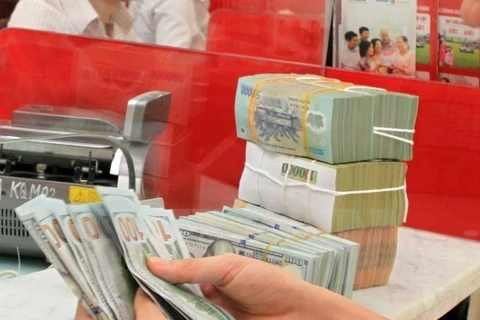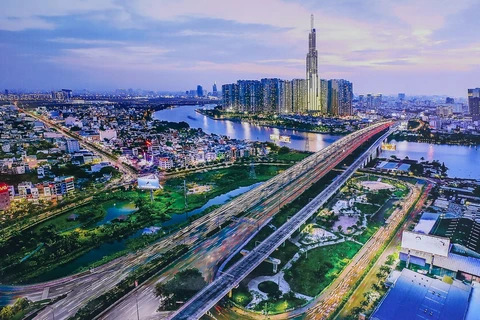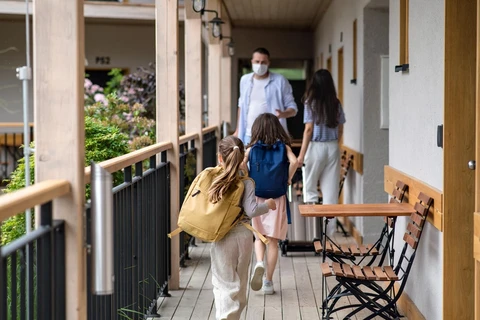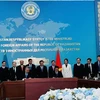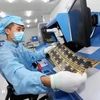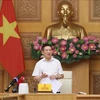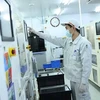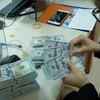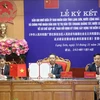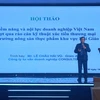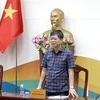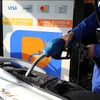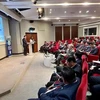
Employees work at an electronic firm in Yen Phong industrial park in Bac Ninh province. (Photo: VNA)
Hanoi (VNA) – HSBC Vietnam has mapped out two scenarios for Vietnam’s economy until the end of the year, which focused on the re-opening of the economy, according to its Chief Executive Officer (CEO) Tim Evans.
In the first scenario, the country’s gross domestic product (GDP) will grow 5-5.5 percent, depending on the speed and effectiveness of the vaccine rollout, the re-opening of the economy and the recovery and resumption of major export markets, given the challenges posed by Delta variant of coronavirus SARS-CoV-2.
In the second scenario, if the vaccination programme is not quick enough and lockdown and social distancing continue to be lengthened, there will be a more adverse impact to the economy and there will be increased pressure on supply chains and GDP may only reach 3.5-4 percent.
“Either scenario, the economy needs to be re-opened, though in a cautious and systematic way”, Evans stressed.
HSBC’s current forecast for Vietnam’s 2021 GDP growth has been lowered to 5.1 percent, reflecting the severe impact of the fourth wave of COVID-19 infections.
“The only way to come out of this situation is through active vaccination and ensuring that the medical professionals have the resources to handle those who are most adversely impacted from a health perspective by the virus,” the HSBC CEO said.
“We believe consumption will bounce back sharply once the current COVID-19 wave subsides,” he added.
Evans attributed his comment to the fact the State Bank of Vietnam (SBV) has introduced reforms to help support the economy. It has increased credit growth for some commercial banks from an earlier 10-12 percent to 14-15 percent for this year and hopefully, consideration may be given for a further increase to support the corporate sector. This will help banks to lend additional loans that can help to counter the slowdown as lockdowns and social distancing have drained corporate cash flows.
The central bank has also advised that the lending interest rates for businesses and people hit hard by the pandemic should be lowered. In response, 16 commercial banks have reduced interest rates on existing loans which should help corporations with their cash flows.
As the economy starts to reopen, supply chain challenges should subside, orders will resume and FDI should resume its cadence given the Government’s consistent policies, hardworking workforce, a large number of free trade agreement (FTAs) and a commitment from the government to spend seven percent of GDP on developing infrastructure.
The HSBC CEO supposed that the country remains a highly attractive investment destination in the medium term. This is based on the country’s robust fundamentals which many investors will look through the present COVID-19 volatilities.
As more economies begin to open up in the region on the back of large scale vaccine rollout, this coupled with the ongoing demand from Europe and North America should see the positive impact on the exports of technology-related products, machinery, footwear, garments, furniture, food, and agricultural products.
Meanwhile, Evans highlighted that Vietnam’s strong fundamentals remain and the country has built an enviable position in the global supply chains over the past years through its set of FTAs.
Strong foreign currency reserves coupled with a stable currency, inflation is under control, continued strong FDI inflows with an emphasis on the manufacturing sector all position Vietnam will for the future. As a result, HSBC is forecasting GDP growth of 6.8 percent for the country in 2022 with a bullish outlook for the mid and long term.
“Our guidance to our customers is that we need to look through this short term pain and to start to plan for the future when we come out the other side of this terrible pandemic. There will be opportunities, there will be economic growth, Vietnam will bounce back and once again prove that when it comes to overcoming a challenge or obstacle, no one does it better than Vietnam,” he said./.


